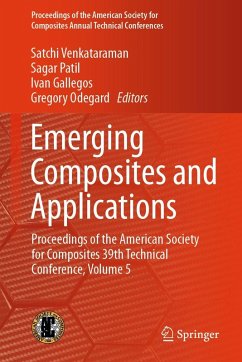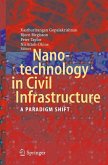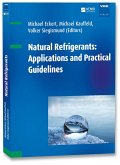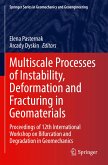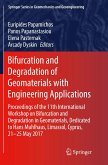Emerging Composites and Applications
Proceedings of the American Society for Composites 39th Technical Conference, Volume 5
Herausgegeben:Venkataraman, Satchi; Patil, Sagar; Gallegos, Ivan; Odegard, Gregory
Emerging Composites and Applications
Proceedings of the American Society for Composites 39th Technical Conference, Volume 5
Herausgegeben:Venkataraman, Satchi; Patil, Sagar; Gallegos, Ivan; Odegard, Gregory
- Gebundenes Buch
- Merkliste
- Auf die Merkliste
- Bewerten Bewerten
- Teilen
- Produkt teilen
- Produkterinnerung
- Produkterinnerung
This book presents the proceedings of the American Society for Composites 39th Technical Conference. This volume, the fifth of six volumes,. This volume brings together contributions to developing emerging composites and application-based research of composite materials systems. The contents of this volume will be useful to researchers, academics, and industry professionals alike.
Andere Kunden interessierten sich auch für
![Nanotechnology in Civil Infrastructure Nanotechnology in Civil Infrastructure]() Nanotechnology in Civil Infrastructure77,99 €
Nanotechnology in Civil Infrastructure77,99 €![Construction Machines Construction Machines]() Dinko MikulicConstruction Machines106,99 €
Dinko MikulicConstruction Machines106,99 €![Natural Refrigerants: Applications and Practical Guidelines Natural Refrigerants: Applications and Practical Guidelines]() Natural Refrigerants: Applications and Practical Guidelines59,00 €
Natural Refrigerants: Applications and Practical Guidelines59,00 €![Multiscale Processes of Instability, Deformation and Fracturing in Geomaterials Multiscale Processes of Instability, Deformation and Fracturing in Geomaterials]() Multiscale Processes of Instability, Deformation and Fracturing in Geomaterials166,99 €
Multiscale Processes of Instability, Deformation and Fracturing in Geomaterials166,99 €![Multiscale Processes of Instability, Deformation and Fracturing in Geomaterials Multiscale Processes of Instability, Deformation and Fracturing in Geomaterials]() Multiscale Processes of Instability, Deformation and Fracturing in Geomaterials166,99 €
Multiscale Processes of Instability, Deformation and Fracturing in Geomaterials166,99 €![Bifurcation and Degradation of Geomaterials with Engineering Applications Bifurcation and Degradation of Geomaterials with Engineering Applications]() Bifurcation and Degradation of Geomaterials with Engineering Applications151,99 €
Bifurcation and Degradation of Geomaterials with Engineering Applications151,99 €![Construction Machines Construction Machines]() Dinko MikulicConstruction Machines76,99 €
Dinko MikulicConstruction Machines76,99 €-
-
-
This book presents the proceedings of the American Society for Composites 39th Technical Conference. This volume, the fifth of six volumes,. This volume brings together contributions to developing emerging composites and application-based research of composite materials systems. The contents of this volume will be useful to researchers, academics, and industry professionals alike.
Produktdetails
- Produktdetails
- Proceedings of the American Society for Composites Annual Technical Conferences
- Verlag: Springer / Springer Nature Switzerland / Springer, Berlin
- Artikelnr. des Verlages: 89552424, 978-3-032-05219-3
- Seitenzahl: 277
- Erscheinungstermin: 22. Dezember 2025
- Englisch
- Abmessung: 235mm x 155mm
- ISBN-13: 9783032052193
- ISBN-10: 303205219X
- Artikelnr.: 75134374
- Herstellerkennzeichnung
- Springer-Verlag GmbH
- Tiergartenstr. 17
- 69121 Heidelberg
- ProductSafety@springernature.com
- Proceedings of the American Society for Composites Annual Technical Conferences
- Verlag: Springer / Springer Nature Switzerland / Springer, Berlin
- Artikelnr. des Verlages: 89552424, 978-3-032-05219-3
- Seitenzahl: 277
- Erscheinungstermin: 22. Dezember 2025
- Englisch
- Abmessung: 235mm x 155mm
- ISBN-13: 9783032052193
- ISBN-10: 303205219X
- Artikelnr.: 75134374
- Herstellerkennzeichnung
- Springer-Verlag GmbH
- Tiergartenstr. 17
- 69121 Heidelberg
- ProductSafety@springernature.com
Satchi Venkataraman, Ph.D., is a Professor of Aerospace Engineering at San Diego State University. His expertise is in the areas of Composite Materials, Progressive and Fatigue Failure Predictions in Composites, Design of Optimal tests for Model Validation and Calibration, Aerospace Structures Analysis and Design, Structural Optimization, Uncertainty Quantification, and Biomimetic Design. He was a technical co-organizer for the 2024 American Society for Composites Technical Conference. Sagar Patil is a postdoctoral scholar with research focusing on computational-driven design of high-performance materials to establish structure-property-processing relationships. He received his PhD from Michigan Technological University. Sagar’s research interests are implementing molecular dynamics and density functional theory to model complex chemistries in thermosets and thermoplastic materials for process modeling, space and energy storage applications. Ivan Gallegos was a postdoctoral scholar with expertise in atomistic modeling of pyrolysis to produce carbon and ceramic matrices. He has shifted his focus to pyrolytic chemistry of jet fuels and is currently at the Air Force Research Laboratory. Gregory Odegard is the John O. Hallquist Endowed Chair in Computational Mechanics in the Department of Mechanical Engineering – Engineering Mechanics at Michigan Tech. He is the Director of the NASA Institute for Ultra-Strong Composites by Computational Design, which is focused on developing the next generation of composite materials for crewed deep-space missions. Before joining the faculty at Michigan Tech, Greg was a researcher at NASA Langley Research Center from 2000-2004. He received his PhD at the University of Denver in 2000. His research is focused on computational modeling of advanced composite systems. He is the recipient of the NASA Outstanding Public Leadership Medal, is a Fellow of ASME, and an Associate Fellow of AIAA.
Part 1: Composites in Space and Deployable Structures.- Chapter 1: Analysis of Triangular Rollable and Collapsible Composite Booms Under the Effects of Gravity and Twist.- Chapter 2: Experimental Setup for Mechanically Testing Subscale Triangular, Rollable, and Collapsible Deployable Composite Booms.- Chapter 3: Innovative Joining Method for Hybrid Composites with Tailored Performance.- Chapter 4: Three-Dimensional Structural Analysis of Shell Structures Using MSG Based Beam Model.- Part 2: Emerging Composites.- Chapter 5: Characterization of In-plane Compressive Response of Triangular Honeycomb Carbon Fiber Epoxy Composite Fabricated via Direct-Ink-Writing.- Chapter 6: Comparison of Fabricating Polymer-Fiber-Reinforced Polymers (PFRPs) Between Powder Impregnation and Film Stacking Methods.- Part 3: Nanocomposites.- Chapter 7: Development of Hierarchical Multifunctional Polymeric and Ceramic Nanocomposites.- Chapter 8: Fiber Interface Modification via Aqueous Dispersion-Based Electrophoretic Deposition of High-Performance Thermoplastics and Resistive Joule Heating Process.- Chapter 9: Microstructure and Manufacturing Process Impact on Effective Material Properties in Carbon/Ultra-High-Molecular-Weight-Polyethylene Nanocomposites.- Chapter 10: Predicting Fracture Toughness in Polymer Nanocomposites Using Concurrently Coupled Atomistic-Continuum Simulations.- Part 4: Natural Fiber Reinforced Composites.- Chapter 11: Bio-Based Epoxy Natural Fiber Composites for Marine Energy Harvesting.- Chapter 12: Design of a Pultrusion System for Hemp-Based Rebar.- Chapter 13: Effect of Environmental Aging on the Thermal and Chemical Properties of Flax Fiber-Polypropylene Natural Fiber Reinforced Thermoplastic Composites.- Chapter 14: Enhancement Method of the Paper Strengths by Infiltrating Photocurable Resin and Cellulose Nanofibers.- Chapter 15: Enhancing Thermal and Mechanical Properties of Polypropylene Composites Using Agave Fibers: A Sustainable Approach for Green Composite Materials.- Chapter 16: Interesting Properties of 3D Woven Composite Material Made with Different Bio-Sourced Yarns.- Chapter 17: Mechanical Property and Thermal Stability Characterization of Additively Manufactured Chicken Feather Fiber/Polybutylene Succinate (PBS) Green Composites.- Chapter 18: Synergistic Enhancement of Mechanical Properties in Flax Fibers by Supercritical Fluid and TiO2 Nanoparticles.- Part 5: Thermoplastic Composites.- Chapter 19: Dependence of Microstructure and Flexural Response of Thin-Shell Carbon Fiber/PA6 Composite on Ply Thickness.- Chapter 20: Implanted Sensor for the Monitoring of Temperature of Incoming Tape in Automated Fiber Placement of Thermoplastic Composites.- Chapter 21: Investigating Vacuum Bag-Only Consolidation of CF-PEEK Panels Made via Automated Fiber Placement.- Chapter 22: Structural Sizing of a 50-m-Tall Thermoplastic Composite Solar Array Truss Tower Structure for the Lunar South Pole.- Chapter 23: Validating Coarse-Grained Models of Thermoplastics for Fusion Welding.
Part 1: Composites in Space and Deployable Structures.- Chapter 1: Analysis of Triangular Rollable and Collapsible Composite Booms Under the Effects of Gravity and Twist.- Chapter 2: Experimental Setup for Mechanically Testing Subscale Triangular, Rollable, and Collapsible Deployable Composite Booms.- Chapter 3: Innovative Joining Method for Hybrid Composites with Tailored Performance.- Chapter 4: Three-Dimensional Structural Analysis of Shell Structures Using MSG Based Beam Model.- Part 2: Emerging Composites.- Chapter 5: Characterization of In-plane Compressive Response of Triangular Honeycomb Carbon Fiber Epoxy Composite Fabricated via Direct-Ink-Writing.- Chapter 6: Comparison of Fabricating Polymer-Fiber-Reinforced Polymers (PFRPs) Between Powder Impregnation and Film Stacking Methods.- Part 3: Nanocomposites.- Chapter 7: Development of Hierarchical Multifunctional Polymeric and Ceramic Nanocomposites.- Chapter 8: Fiber Interface Modification via Aqueous Dispersion-Based Electrophoretic Deposition of High-Performance Thermoplastics and Resistive Joule Heating Process.- Chapter 9: Microstructure and Manufacturing Process Impact on Effective Material Properties in Carbon/Ultra-High-Molecular-Weight-Polyethylene Nanocomposites.- Chapter 10: Predicting Fracture Toughness in Polymer Nanocomposites Using Concurrently Coupled Atomistic-Continuum Simulations.- Part 4: Natural Fiber Reinforced Composites.- Chapter 11: Bio-Based Epoxy Natural Fiber Composites for Marine Energy Harvesting.- Chapter 12: Design of a Pultrusion System for Hemp-Based Rebar.- Chapter 13: Effect of Environmental Aging on the Thermal and Chemical Properties of Flax Fiber-Polypropylene Natural Fiber Reinforced Thermoplastic Composites.- Chapter 14: Enhancement Method of the Paper Strengths by Infiltrating Photocurable Resin and Cellulose Nanofibers.- Chapter 15: Enhancing Thermal and Mechanical Properties of Polypropylene Composites Using Agave Fibers: A Sustainable Approach for Green Composite Materials.- Chapter 16: Interesting Properties of 3D Woven Composite Material Made with Different Bio-Sourced Yarns.- Chapter 17: Mechanical Property and Thermal Stability Characterization of Additively Manufactured Chicken Feather Fiber/Polybutylene Succinate (PBS) Green Composites.- Chapter 18: Synergistic Enhancement of Mechanical Properties in Flax Fibers by Supercritical Fluid and TiO2 Nanoparticles.- Part 5: Thermoplastic Composites.- Chapter 19: Dependence of Microstructure and Flexural Response of Thin-Shell Carbon Fiber/PA6 Composite on Ply Thickness.- Chapter 20: Implanted Sensor for the Monitoring of Temperature of Incoming Tape in Automated Fiber Placement of Thermoplastic Composites.- Chapter 21: Investigating Vacuum Bag-Only Consolidation of CF-PEEK Panels Made via Automated Fiber Placement.- Chapter 22: Structural Sizing of a 50-m-Tall Thermoplastic Composite Solar Array Truss Tower Structure for the Lunar South Pole.- Chapter 23: Validating Coarse-Grained Models of Thermoplastics for Fusion Welding.

